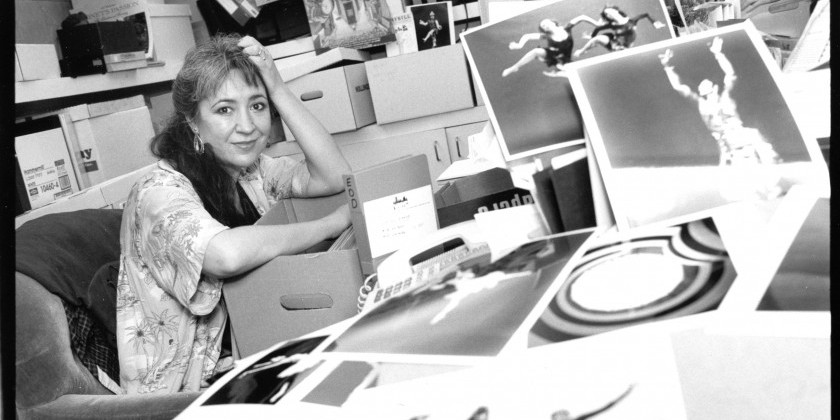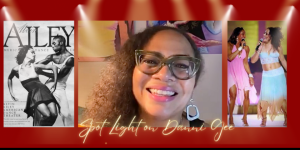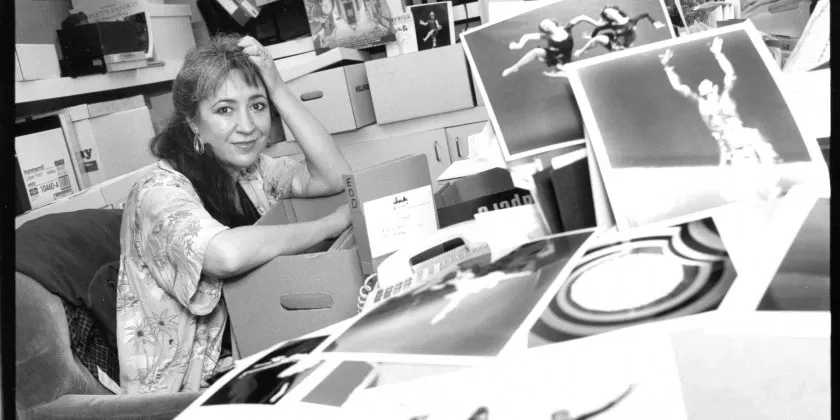DAY IN THE LIFE OF DANCE: 40 Years of EYE ON DANCE with Celia Ipiotis, the Story Behind a National Dance Treasure

Join The Dance Enthusiast in Celebrating 40 Years of EYE ON DANCE on Sunday March 28th, from 4 to 5:30 PM on Zoom
Click HERE to register here for our event!
Imagine a weekly TV show dedicated to stories of dance.
During one week, you might learn about the history of tap by watching Gregory Hines conversing with his mentor, Charles “Honi” Coles. On another, you might be surprised to meet the German immigrant and theatrical dancer, Eugene Von Grona, who created 1934’s American Negro Ballet Company in New York. He would be speaking with one of his original company dancers, Lavinia Williams, an artist more recognized for her work with Katherine Dunham and contribution to Haitian dance than as a ballerina. Did you know there was an all-Black ballet company in the United States in the 1930s? (*see note)
Wouldn’t it be great to hear two movement artists, who are contemporaries both named Bill — the post-modernist Bill T. Jones and the theatrical, actor-clown Bill Irwin — talk to each other about relating to audiences?
Yes.
Am I dreaming?
No.
EYE ON DANCE was that spectacular weekly program. The love child of dancer, choreographer, producer, and video artist Celia Ipiotis, and video innovator, Jeff Bush, the show ran on PBS from 1981-2004, with Nielsen ratings revealing that hundreds of thousands of people tuned in to watch.

Those devotees sat in front of their TVs, not to catch performances or rate dance contests, but to listen to dancers of all genres, as well as musicians, lawyers, critics, movement therapists, and historians, engaged in dynamic, themed conversations covering their experiences in the arts.
“And every time they tuned in, they didn't know what they were going to get,” says Ipiotis, who, in addition to planning and co-producing, hosted the show.
“I was getting my ideas for what the program would be on my way to performances, listening to what everyone was talking about: gender politics, AIDS issues, the institutionalization of the arts. This was the dance boom of the 1980s, into the '90s. It was a glorious time, a phenomenal time. There were so many ideas, iconoclasts, and idealists, just a simmering brilliance of conflicting and coordinating ethics and aesthetics.”
Ipiotis and Bush, fans of the early PBS news program The MacNeil/Lehrer Report (precursor to the current News Hour on PBS), worked to bring the same type of depth, research, and quality of perspectives to EYE ON DANCE that they appreciated in their news programming.
With this ethos, they created the first-ever televised dance educational news program, a serious, informative, inspiring, and lively show, now referred to as a national treasure.
The ORIGINS of EYE ON DANCE
A professional dancer working in ballet, modern, and musical theater from age 11, Ipiotis appeared on television early in her career. She became fascinated with the difference between the dance she performed for the camera in that “itsy-bitsy studio” and its appearance on the television monitor.

By the time she attended Ohio State University, already an accomplished dance professional, Ipiotis was seeking something new. Interdisciplinary studies, for example, discussing the relationship between dance and all artistic mediums, especially film, appealed to her.
She was one of the first students who walked into dance studios with a camera in hand, much to the annoyance of some professors. But Helen Alkire, the OSU dance department head, championed Ipioitis, telling the teachers to let her film.

“Therefore, I did,” Ipiotis energetically claims. “It didn’t matter to me if it was technique or improv or choreography class. I just wanted to be in there to see all the different angles and how the movement changed when you zoomed in and out. It was my experimentation, my understanding of the camera.”
After college, still intrigued by the possibilities of dance on television and film, Ipiotis was fascinated by a groundbreaking article in 1975’s Spring/Summer Dance Scope magazine, authored by Jeff Bush and Peter Z. Grossman. A manifesto for video dance, it spoke of previous examples of dance on television as failing the art form and underscored the need for video techniques, which supported dance’s unique qualities, as opposed to borrowing from approaches used in theater or news production. The feature posited that dance designed specifically for camera, with camera work and choreography in partnership, could create a “force in the world of dance.”

Ipiotis headed to the New School in New York City for graduate work, expressly to meet and learn from Bush, a professor there. Expecting some sort of god-like sage with wrinkles and a long white beard, she was surprised to discover that Bush, while sagacious, was a hippie close to her own age. It wasn’t long before the intrepid grad student teamed up (and moved in) with her professor and kindred spirit.
In 1980, the couple applied for a New York State Arts Council’s new programming grant with the novel idea of creating a weekly show dedicated to video experiments happening in the dance world. At the time, video dance was cutting edge, and there was no such thing as video dance on TV. The state arts council, not knowing what to make of Ipiotis and Bush’s unprecedented project, denied it funding. Ironically the next year, MTV exploded onto the world stage, demonstrating how video experimentation with dance, music, and television could launch a new art form.
“We always got caught in that. No one was doing it, so no funding. Not interested,” says Ipiotis.

Undeterred, the two continued their mission, finding creative ways to support their work. They partnered with School District 6 in Washington Heights for the use of their state-of-the-art video equipment. They bartered with WNYE, a PBS station then owned by the New York Board of Education, giving videotaping lessons to students along with use of their black box basement studio in exchange for the ability to work on EYE ON DANCE and have the show broadcasted on PBS.
“That's how EYE ON DANCE was launched initially,” says Ipiotis. “As we began talking, I was thinking, oh my god, people know so little about dance, all they think about are the steps on the stage. And that's just the tip of the iceberg. Each week, I could choose a different topic and then investigate that topic with dancers.”

Truly imperative to the success of EYE ON DANCE was the show being picked up, in 1983, by WNYC-TV. Headed by the dynamic Mary Nichols, WNYC public TV served the broad New York tri-state area and had better funding and more sophisticated equipment than WNYE. The channel demanded exacting standards of its content and technical aspects, so just to be there was an immediate acknowledgment of EYE ON DANCE’s caliber. Even more exciting, the young dance show was placed directly on WNYC's primetime lineup by the channel's programming director, Madison Davis Lacy.
THE PROGRAMS
“The first four weeks of EYE ON DANCE was devoted to the topic of designing dance for the camera,” says Ipiotis. "I already knew that community, so it was easy for me to reach out and get the people by phone.”
"That's what you did then,” she reminds me. “This is pre-computer days. We were able to get guests, and they immediately started to talk about the show; soon others heard about us, and it just started to build on itself.”

She developed a roster of champions, dance whisperers, who believed in the project and helped her find guests. “They thought that the show was intelligent and animated, and they wanted to assist,” says Ipiotis. One of the first people to help, among dozens of others, was the dance historian and critic, Selma Jean Cohen. “She had everyone’s address and phone number.”
“I would also read The New York Times and The New Yorker and, at that time, all these downtown papers, including the New York Native, the Soho News, and Village Voice. I would lay out eight different publications to help me figure out what subject we were gonna tackle.”
%20Colon.png)
DID YOU UNDERSTAND THE IMPORTANCE OF EYE ON DANCE WHILE IN THE MIDDLE OF CREATING IT?
Ipiotis replies, “I never thought while I was doing it or when I started that this would end up being such a significant historical archive of dance during those couple of decades in America. I started to get it a few years in about 1984, and that’s because the AIDS crisis had already begun in 1981, and I saw that we were losing people.”

One of her favorite interviewees was Alvin Ailey, who died of the disease in 1989. “It was the last interview before his untimely death, but we did not discuss AIDS on the program because that wasn't my topic. My topic was Alvin Ailey, and how he developed the idea for his dance company. There was concern, whether or not he would be healthy enough on that day to show up, so I was in a bit of a panic mode the whole day just waiting at home to see if I was going to get a phone call—this was before cell phones. But he arrived perfectly on time, looking gorgeous, and our conversation was like sitting on the front porch on a warm summer evening. We were looking back over his life and the magnificent developments that he was responsible for, most importantly, that the house that Ailey built was a sanctuary for African-American dancers and choreographers.”

“I also really loved Merce Cunningham. When he came, I was beside myself because here he was doing video dancing, my big love, and I was able to talk in detail with someone who would understand everything that I was saying. I didn't have to clarify or explain. He knew we were right on the same plane on how you design for the camera, the issues, the idea of expanding the creative reaches of dance to include video. That was a thrill.”
THE AUDIENCE
Unusually for a dance program, more the 50% of the viewing audience was male, with a strong African-American contingent of viewers. Ipiotis believes this is because Black people saw themselves, their work, and history taken seriously in her coverage. Ipiotis remembers a young African-American jazz player who said that he and his 12-year-old son would watch every week, calling the program “must-watch TV.”

She received a plethora of letters from fans describing the show’s effect on them. “I had dancers who had their parents watching so they could understand why their children were dancers; people who watched who had never seen a dance performance before, who as a result of watching EYE ON DANCE went out to see dance; there were people who were die-hard ballet people who wrote to say that, as a result of watching EYE ON DANCE, they actually went downtown to see a performance, someplace that they never conceived they would go.”
One could say the success of EYE ON DANCE was based on the extensive research that went into it, the curiosity and engaging nature of its young host, and perhaps the times that the show captured — the 1980s/'90s dance scene, which as Ipiotis says, “was exploding with dance, every single different form and discipline that existed.” But, perhaps the program’s most standout achievement by far was its ability to personalize the dance experience for hundreds of thousands of viewers, dancers and non-dancers alike.
“More than talking about pieces that someone was going to perform, the program instigated and inspired interest,” Ipiotis shares. Audiences would say, “Wow, that show was so fascinating; let’s go out to see what those dancers are doing.”
JOIN US: The Dance Enthusiast Celebrates 40 Years of EYE ON DANCE, "An Irreplaceable National Dance Treasure" in a FREE virtual Enthusiastic Event on Sunday March 28th from 4:00 to 5:30 pm on ZOOM.
Come to our EXCLUSIVE Watch Party and Conversation
CLICK HERE TO REGISTER FOR LINK
Hosted by The Dance Enthusiast’s Founding Editor, Christine Jowers
FEATURING Celia Ipiotis, Creator, Producer, and Host of EYE ON DANCE, and Special Guests Seán Curran, Mercedes Ellington, and Francesca Harper
Save Vital Documentation of Dance History. Help Restore EYE ON DANCE Episodes for access by Future Generations. DONATE HERE
Broadcast from 1981-2004 through their nonprofit organization, the EYE ON DANCE Legacy Archive includes 2400 tapes, and reams of materials associated with the making of each program: personal communications, production notes, publications, photographs, programs, press materials and more.
Celia Ipiotis and Jeff Bush are currently raising funds to restore distressed videotapes and associated materials for access by future generations. Restored EOD episodes are distributed to universities and libraries.
*Footnote First Negro Ballet MoBBallet.org Curating the Memoirs of Blacks in Ballet













